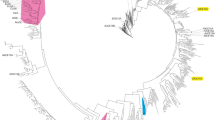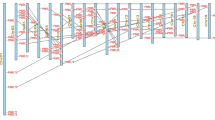Abstract
Phosphoenolpyruvate carboxylase (PEPCase, EC 4.1.1.3) is a key enzyme of C4 photosynthesis. It has evolved from ancestral non-photosynthetic (C3) isoforms and thereby changed its kinetic and regulatory properties. We are interested in understanding the molecular changes, as the C4 PEPCases were adapted to their new function in C4 photosynthesis and have therefore analysed the PEPCase genes of various Alternanthera species. We isolated PEPCase cDNAs from the C4 plant Alternanthera pungens H.B.K., the C3/C4 intermediate plant A. tenella Colla, and the C3 plant A. sessilis (L.) R.Br. and investigated the kinetic properties of the corresponding recombinant PEPCase proteins and their phylogenetic relationships. The three PEPCases are most likely derived from orthologous gene classes named ppcA. The affinity constant for the substrate phosphoenolpyruvate (K 0.5 PEP) and the degree of activation by glucose-6-phosphate classified the enzyme from A. pungens (C4) as a C4 PEPCase isoform. In contrast, both the PEPCases from A. sessilis (C3) and A. tenella (C3/C4) were found to be typical C3 PEPCase isozymes. The C4 characteristics of the PEPCase of A. pungens were accompanied by the presence of the C4-invariant serine residue at position 775 reinforcing that a serine at this position is essential for being a C4 PEPCase (Svensson et al. 2003). Genomic Southern blot experiments and sequence analysis of the 3′ untranslated regions of these genes indicated the existence of PEPCase multigene family in all three plants which can be grouped into three classes named ppcA, ppcB and ppcC.




Similar content being viewed by others
Abbreviations
- Glc6P:
-
Glucose-6-phosphate
- PEP:
-
Phosphoenolpyruvate
- PEPCase:
-
PEP carboxylase
References
Andreo CS, Gonzales DH, Iglesias AA (1987) Higher plant phosphoenolpyruvate carboxylase. FEBS Lett 213:1–8
Bauwe H (1986) An efficient method for the determination of K M values for HCO −3 of phosphoenolpyruvate carboxylase. Planta 169:356–360
Bauwe H, Chollet R (1986) Kinetic properties of phosphoenolpyruvate carboxylase from C3, C4, and C3-C4 intermediate species of Flaveria (Asteraceae). Plant Physiol 82:695–699
Besnard G, Pincon G, D’Hont A, Hoarau JY, Cadet F, Offmann B (2003) Characterisation of the phosphoenolpyruvate carboxylase gene family in sugarcane (Saccharum spp). Theor Appl Genet 107:470–478
Bläsing OE, Westhoff P, Svensson P (2000) Evolution of C4 phosphoenolpyruvate carboxylase in Flaveria, a conserved serine residue in the carboxyl-terminal part of the enzyme is a major determinant for C4-specific characteristics. J Biol Chem 275: 27917–27923
Bläsing OE, Ernst K, Streubel M, Westhoff P, Svensson P (2002) The non-photosynthetic phosphoenolpyruvate carboxylases of the C4 dicot Flaveria trinervia-implications for the evolution of C4 photosynthesis. Planta 215:448–456
Chinthapalli B, Raghavan C, Bläsing OE, Westhoff P, Raghavendra AS (2000) Phosphoenolpyruvate carboxylase purified from leaves of C3, C4, and C3-C4 intermediate species of Alternanthera: properties at limiting and saturating bicarbonate. Photosynthetica 38:415–419
Chollet R, Vidal J, O’Leary MH (1996) Phosphoenolpyruvate carboxylase: a ubiquitous, highly regulated enzyme in plants. Annu Rev Plant Physiol Plant Mol Biol 47:273–298
Devi MT, Raghavendra AS (1993) Partial reduction in activities of photorespiratory enzymes in C3-C4 intermediates of Alternanthera and Parthenium. J Exp Bot 44:779–784
Devi MT, Rajagopalan AV, Raghavendra AS (1995) Predominant localization of mitochondria enriched with glycine-decarboxylating enzymes in bundle sheath cells of Alternanthera tenella, a C3-C4 intermediate species. Plant Cell Environ 18:589–594
Dong LY, Masuda T, Kawamura T, Hata S, Izui K (1998) Cloning, expression, and characterization of a root-form phosphoenolpyruvate carboxylase from Zea mays: comparison with the C4-form enzyme. Plant Cell Physiol 39:865–873
Duff SMG, Chollet R (1995) In vivo regulation of wheat-leaf phosphoenolpyruvate carboxylase by reversible phosphorylation. Plant Physiol 107:775–782
Engelmann S, Bläsing OE, Westhoff P, Svensson P (2002) Serine 774 and amino acids 296 to 437 comprise the major C4 determinants of the C4 phosphoenolpyruvate carboxylase of Flaveria trinervia. FEBS Lett 524:11–14
Engelmann S, Bläsing OE, Gowik U, Svensson P, Westhoff P (2003) Molecular evolution of C4 phosphoenolpyruvate carboxylase in the genus Flaveria—a gradual increase from C3 to C4 characteristics. Planta 217:717–725
Ernst K, Westhoff P (1996) The phosphoenolpyruvate carboxylase (ppc) gene family of Flaveria trinervia (C4) and F. pringlei (C3): molecular characterization and expression analysis of the ppcB and ppcC genes. Plant Mol Biol 34:427–443
Feinberg AP, Vogelstein B (1983) A technique for radiolabeling DNA restriction endonuclease fragments to high specific activity. Anal Biochem 132:6–13
Gowik U, Burscheidt J, Akyildiz M, Schlue U, Koczor M, Streubel M, Westhoff P (2004) cis-Regulatory elements for mesophyll-specific gene expression in the C4 plant Flaveria trinervia, the promoter of the C4 phosphoenolpyruvate carboxylase gene. Plant Cell 16:1077–1090
Hatch MD (1987) C4 photosynthesis: a unique blend of modified biochemistry, anatomy and ultrastructure. Biochim Biophys Acta 895:81–106
Jiao J, Chollet R (1991) Posttranslational regulation of phosphoenolpyruvate carboxylase in C4 and Crassulacean acid metabolism plants. Plant Physiol 95:981–985
Kai Y, Matsumura H, Izui K (2003) Phosphoenolpyruvate carboxylase: three-dimensional structure and molecular mechanisms. Arch Biochem Biophys 414:170–179
Kellogg EA (1999) Phylogenetic aspects of the evolution of C4 photosynthesis. In: Sage RF, Monson RK (eds) C4 plant biology. Academic, San Diego, pp 411–444
Koprivova A, Melzer M, vonBallmoos P, Mandel T, Brunold C, Kopriva S (2001) Assimilatory sulfate reduction in C-3, C-3-C-4, and C-4 species of Flaveria. Plant Physiol 127:543–550
Latzko E, Kelly J (1983) The multi-faceted function of phosphoenolpyruvate carboxylase in C3 plants. Physiol Vég 21:805–815
Müller K, Borsch T (2005) Phylogenetics of Amaranthaceae using matK/trnK sequence data—evidence from parsimony, likelihood and Bayesian approaches. Ann Miss Bot Gard 92:66–102
Poetsch W, Hermans J, Westhoff P (1991) Multiple cDNAs of phosphoenolpyruvate carboxylase in the C4 dicot Flaveria trinervia. FEBS Lett 292:133–136
Rajagopalan AV, Devi MT, Raghavendra AS (1994) Molecular biology of C4 phosphoenolpyruvate carboxylase: structure, regulation and genetic engineering. Photosyn Res 39:115–135
Rajendrudu G, Prasad JSR, Das VSR (1986) C3-C4 intermediate species in Alternanthera (Amaranthaceae). Leaf anatomy, CO2 compensation point, net CO2 exchange and activities of photosynthetic enzymes. Plant Physiol 80:409–414
Rosche E, Westhoff P (1995) Genomic structure and expression of the pyruvate,orthophosphate dikinase gene of the dicotyledonous C4 plant Flaveria trinervia (Asteraceae). Plant Mol Biol 29:663–678
Sabe N, Miwa T, Kodaki T, Izui K, Hiraga S, Katzuki H (1984) Molecular cloning of the phosphoenolpyruvate carboxylase gene, ppc, of Escherichia coli. Gene 31:279–283
Sage RF (2004) The evolution of C4 photosynthesis. New Phytol 161:341–370
Sambrook J, Russell DW (2001). Molecular cloning. A laboratory manual. Cold Spring Harbor Laboratory Press, Cold Spring Harbor
Sánchez R, Cejudo FJ (2003) Identification and expression analysis of a gene encoding a bacterial-type phosphoenolpyruvate carboxylase from Arabidopsis and rice. Plant Physiol 132:949–957
Sheen J (1999) C4 gene expression. Annu Rev Plant Physiol Plant Mol Biol 50:187–217
Siebert PD, Chenchik A, Kellogg DE, Lukyanov KA, Lukyanov SA (1995) An improved PCR method for walking in uncloned genomic DNA. Nucleic Acids Res 23:1087–1088
Soltis DE, Soltis PS, Bennett MD, Leitch IJ (2003) Evolution of genome size in the angiosperms. Am J Bot 90:1596–1603
Sullivan S, Jenkins GI, Nimmo HG (2004) Roots, cycles and leaves. Expression of the phosphoenolpyruvate carboxylase kinase gene family in soybean. Plant Physiol 135:2078–2087
Svensson P, Bläsing OE, Westhoff P (1997) Evolution of the enzymatic characteristics of C4 phosphoenolpyruvate carboxylase: a comparison of the orthologous ppcA phosphoenolpyruvate carboxylases of Flaveria trinervia (C4) and F. pringlei (C3). Eur J Biochem 246:452–460
Svensson P, Bläsing OE, Westhoff P (2003) Evolution of C4 phosphoenolpyruvate carboxylase. Arch Biochem Biophys 414:180–188
Swofford DL (2002) PAUP*: Phylogenetic analysis using parsimony (and other methods) 4.0. Sinauer Associates, Inc. Sunderland
Thompson JD, Gibson TJ, Plewniak F, Jeanmougin F, Higgins DG (1997) The CLUSTAL_X windows interface: flexible strategies for multiple sequence alignment aided by quality analysis tools. Nucleic Acids Res 25:4876–4882
Toh H, Kawamura T, Izui K (1994) Molecular evolution of phosphoenolpyruvate carboxylase. Plant Cell Environ 17:31–43
Wendel JF (2000) Genome evolution in polyploids. Plant Mol Biol 42:225–249
Westhoff P, Offermann-Steinhard K, Höfer M, Eskins K, Oswald A, Streubel M (1991) Differential accumulation of plastid transcripts encoding photosystem II components in the mesophyll and bundle-sheath cells of monocotyledonous NADP-malic enzyme-type C4 plants. Planta 184:377–388
Wolfe KH (2001) Yesterday’s polyploids and the mystery of diploidization. Nat Rev Genet 2:1–9
Acknowledgements
This work was supported by the Volkswagen-Stiftung through project 71371.We thank Wilhelm Rogmann and his greenhouse staff for expert care of our plants, Karin Ernst, Sascha Laubinger and members of the laboratory for helpful discussions.
Author information
Authors and Affiliations
Corresponding author
Rights and permissions
About this article
Cite this article
Gowik, U., Engelmann, S., Bläsing, O.E. et al. Evolution of C4 phosphoenolpyruvate carboxylase in the genus Alternanthera: gene families and the enzymatic characteristics of the C4 isozyme and its orthologues in C3 and C3/C4 Alternantheras . Planta 223, 359–368 (2006). https://doi.org/10.1007/s00425-005-0085-z
Received:
Accepted:
Published:
Issue Date:
DOI: https://doi.org/10.1007/s00425-005-0085-z




